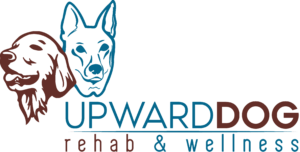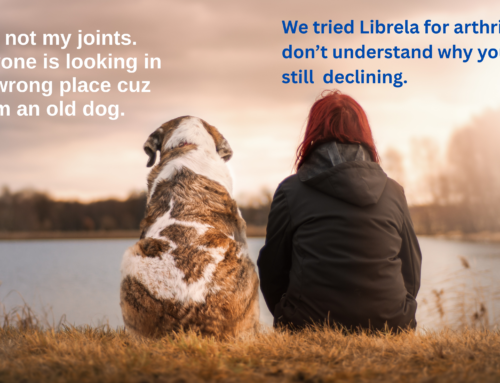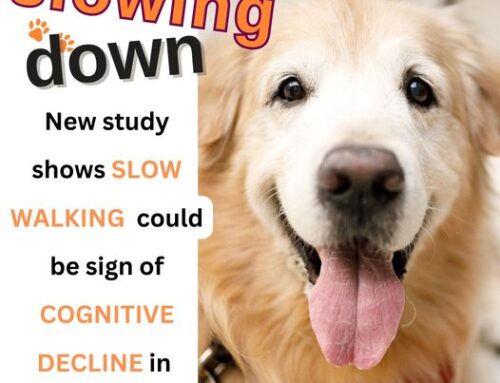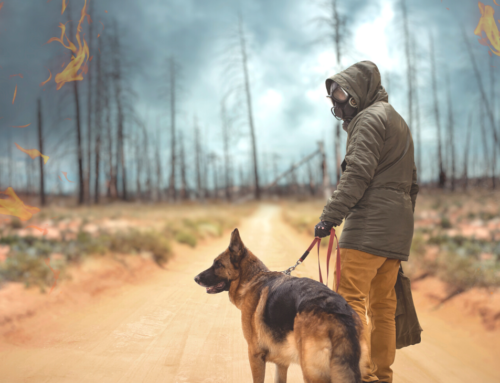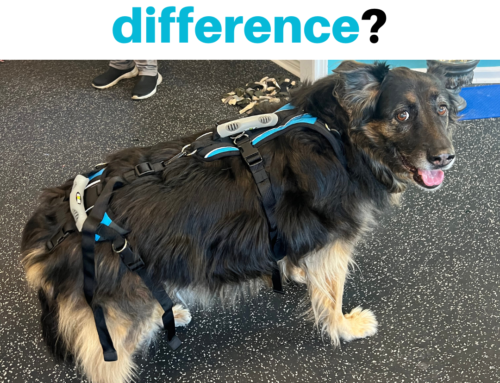I’ve recently had an influx of senior dogs with significant hind limb pain and weakness, into my canine rehab practice… and many pet parents hoping for a Hail Mary, so I think this would be a really good topic to discuss. And I’ve shared some helpful links, resources, and free downloads!
Sadly, many pet parents tell me, they didn’t know canine rehab was a thing, that help like this even existed. If you are a pet parent that has experienced this scenario, I’m sorry. We are a small profession of physiotherapists, veterinarians, and vet techs with specialized training and are still working on raising awareness. If you are a vet, please refer to us when dogs have a decline in mobility, in conjunction with your treatment. And send early! A mild decline we can get in front of much easier and address some of the factors that may contribute to declines in mobility in the future versus waiting until a dog has deteriorated significantly.
I’ve also shared links to help you find a canine rehab therapist at the bottom of this blog.
To find out how to help a senior dog with declining hind end mobility, keep reading!

1. Check for Pain/Emergencies/Comorbidities
If your dog is showing changes in personality and/or behaviors and their mobility is also on the downhill slide they are not just getting old. Older dogs are more likely to have comorbidities – multiple conditions occurring at the same time. Have them checked out by your vet and you can request a referral to a canine rehab therapist. The go to diagnosis for senior dogs is arthritis which isn’t always what is causing the mobility decline but a vet visit will rule in/out other things like lyme disease, IVDD, or even kidney or liver problems which can impact mobility, and they can prescribe any necessary pain meds.
2. Neuro or Ortho?
This is a doozy….. I have had lots of pups come for hip arthritis and I find they have beautiful hip extension when their pelvis is supported but their withdrawal reflexes in their pelvic limbs are slow or absent. Sometimes various neurologic conditions initially look like cruciate injuries too. Neuropathic pain makes them sensitive to touch in the limb and the muscle tone (tension in the muscle) is greatly reduced making it look like a stifle injury when in fact it’s not. There are usually other signs too, like back pain and maybe changes in other reflexes. If your dog was running and suddenly yelped and is holding up their leg, this does present a lot like a cruciate (knee) injury and requires a vet visit. If your dog suddenly seems weak in the back end and their head is low and their back haunched, that’s an emergency! Go to the vet immediately! If you are sent home with anti inflammatories yet your dog seems to be very uncomfortable, has a further decline in mobility, or loss of bowel/bladder control, you need to go back to the vet right away!
3. Lifestyle Factors That Really Make A Difference 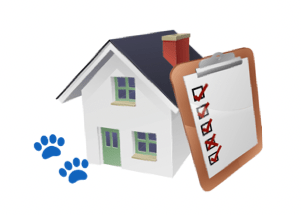
Non slip surfaces! Ever try walking on icy ground with low back pain or a sprained ankle? It doesn’t matter if it’s ortho or neuro, if you want to help your dog use their legs they can’t be slipping around! If your dog is hesitant on stairs, they need grips too, and likely pelvic limb support going up and down.
I do have a free PDF downloadable checklist for improving mobility in the home and reducing the risk of secondary injuries.
One more important note. Keeping your dog at an ideal body weight (you can see a waist line, tummy tuck, and feel their ribs) can significantly reduce their pain, improve their mobility, improve their overall health and may even save you future vet visits. I’ve had clients be shocked at how much better their dog moved and was happier with a small weight loss of about 4% in one month! The Forever Dog Life is a great resource for guidance on food and the appropriate caloric intake for an active versus sedentary dog.
4. Mobility Aids Help Everyone’s Mobility
Proper supports help keep our dogs upright and mobile longer, can be used as temporary gait training tools or long term mobility aids, and reduce the risk of us injuring ourselves while helping our dog.
My go to is a Help em Up harness. It may be the best investment you make in a physical product but don’t buy the fake ones on Amazon, they aren’t as good. Sometimes pet parents are confused about the hip lift with male dogs. Majority of male dogs use a “conventional” hip lift, NOT the U-band. Full details are on the website. If you are in a pinch, you can use a sturdy reusable grocery bag, cut the sides out and you have a sling. Be aware this puts pressure on the bladder so if you have a leaky dog, they might pee! For more mobility aid ideas please do talk to your canine rehab therapist (instead of spending all your money on Amazon on items that don’t work) and then you can visit Vital Vet who has mobility aids organized according to condition!
5. Movement is Medicine but Modify
I can say so many things here… and actually did in the first episode of my new podcast “Dogs that Can”. I will say this now though, movement promotes healing. It increases blood flow to injured areas and enhances metabolic waste removal. The right movement can help reduce pain and swelling and aid in maintaining muscle mass which is critical to the aging dog (and human). There are several studies in human medicine that link sarcopenia (progressive age related muscle loss) with decreases in balance and higher fall risk. The Dog Aging Project had been looking at sarcopenia and the correlation with survival times in dogs. The point here is that the “right” movement is very helpful but the wrong movement for the stage of healing or disease progression could have the opposite effect. Talk to your canine rehab therapist!
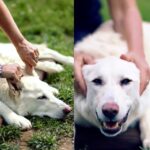 6. Touch is Therapeutic
6. Touch is Therapeutic
I’ve met many pet parents that are nervous to touch their dogs because they don’t want to hurt them. Touch is so important to our companion animals. Can you imagine if people stopped hugging you because you got old?! Now, you do want to relax and never force anything. Massage and T-touch are a great place to start but I really encourage finding a progressional that can also teach you stretching and passive range of motion to help promote joint and tissue health.
7. Stimulate the Brain

Last but not least, stimulate the brain! Short periods of enriching activities and games help stimulate feel good neurotransmitters like dopamine and serotonin. And you can teach an old dog new tricks! I recently taught my 12yo husky mix how to sit on a foam then push up to a stand and put her front paws on a fit bone! This isn’t for every dog but my point is don’t resign your dog as being too old to learn something new as long as their mobility supports it. I have a little DIY youtube video for brain games with your dog here and for more more in depth learning, check out Puzzle Dog!
If you read all the way to the end, you are amazing! And I hope you found some helpful tips to help your dog. Check out the resources below but first the summary points!
Help your dog stay upright and live a longer, healthier life by:
-
Addressing pain and making sure something more insidious isn’t happening
-
Know some of the signs of whether its neurologic, orthopedic, or an emergency
-
Addressing lifestyle factors can reduce pain, keep your dog moving better, and even save dollars
-
Mobility aids aid mobility! Using them helps everyone stay active
-
Movement is medicine when you get the right dose
-
Touch is healing and creates connection
-
Enrichment activities keep your dog young.
If this was helpful please share it with a friend or on social media. And if you are looking for some help with your dog, contact us here!
URLs and Articles Referenced
Click the link to go to the page.
- Home Mobility Assessment Checklist upwarddogrehab.ac-page.com/home-dog-mobility-checklist
- Dogs That Can Podcast https://podcasts.apple.com/ca/podcast/dogs-that-can/id1744983730
- Canine Rehab Therapists Canada https://physiotherapy.ca/app/uploads/2024/03/NK-ARD-Roster-03.25.24.pdf
- Find a Pro USA https://caninerehabsystems.com/find-a-pro/
- Canine Rehab Institute https://www.caninerehabinstitute.com/find-therapist
- Canine Rehab Practitioner https://www.utvetrehab.com/canine-rehab-ccrp/
- Forever Dog Life Recipes and More https://foreverdoglife.com/
- Dog Aging Project https://dogagingproject.org/inside-the-measurement-mobility-activities
- Sarcopenia and its association with falls and fractures in older adults: A systematic review and meta‐analysis https://www.ncbi.nlm.nih.gov/pmc/articles/PMC6596401/
- DIY Brain Games https://youtu.be/Tx9I2UrCChQ?si=QrVVru2PFfutWtv5
- Massage video https://youtu.be/mqR3iU6nmHY
- T-Touch With Tina Constance https://www.facebook.com/share/v/jc3cWPiM97k5qiKe/
- Puzzle Dog https://www.puzzledog.ca
- Vital Vet https://vitalvet.org/
- Help Em Up Harness https://helpemup.com/
